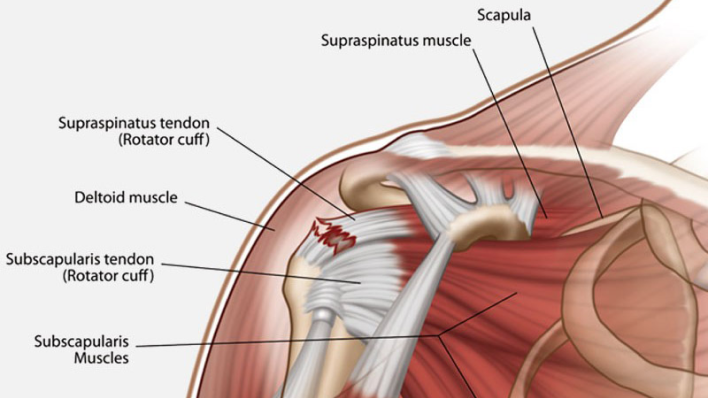Rotator Cuff Tear

Understanding
Rotator Cuff Tear
The rotator cuff is a group of tendons and muscles that stabilize your shoulder joint and let you lift or rotate your arms. It is a medical condition when there is a tear in these tendons. It’s a common cause of shoulder pain among middle-aged and older individuals. A torn rotator cuff tear weakens your shoulders, affecting even daily activities such as combing, getting dressed, baseball or tennis players, painters, and carpenters.
Shoulder / Arm Pain Conditions
Anatomy
The shoulder resembles a ball and joint socket with three significant bones:
- The humorous or upper arm bone
- The scapula or shoulder blade
- The clavicle or collarbone
Common Causes
The primary cause of shoulder tear is acute tear or degenerative tear.
An acute tear in the shoulder can cause injury. It happens when you lift something heavy or fall on your outstretched arm.
The degenerative tear occurs due to the natural wearing down of the tendons over time. The risk of degenerative tear increases due to
- Repetitive stress to the shoulder, like painting, weight lifting, tennis, rowing, and construction work.
- Reduced blood supply as we get older
- Bone spurs can wear off rotator cuff tissues.
- The rotator cuff is typical among people aged above 60
Types
Rotator cuff tears types depend on the severity of the injury.

Partial tear
Partial tear or incomplete tear occurs when the rotator cuff is damaged. Here, the tendon is not entirely detached from the bone. So, you can still use your arm or shoulder with this type of tear.

Complete tear
A complete tear or full-thickness tear happens when the tendon is detached from the bone. It causes severe pain and weakness, preventing one from lifting one's arms.
When is treatment recommended?
Shoulder pain treatment in Dubai is recommended when you have persistent shoulder pain, weakness in the shoulders that affects your daily activities, or consistent pain while lying on the painful side.
Candidate eligible
- People with chronic shoulder or arm pain
- People who want to improve their activity level
- Athletics or sports enthusiasts who wish to continue their participation in sports
Rotator Cuff Tear Symptoms
Symptoms can be occasional. Acute tears have instant pain, but degenerative tear symptoms develop slowly over time. The common symptoms are,
- Pain while resting or at night
- Difficult to raise your arms
- Pain while lifting with your arms
- Crackling sensation while moving your arms
- Weakness while rotating your arms
Treatment Options
Non-surgical treatments
- Physical therapies to strengthen your shoulder muscles
- Exercises to keep your shoulder comfortable and safe
- Appropriate rest to heal.
- Medications such as anti-inflammatory drugs and acetaminophen to reduce pain and swelling.
- Steroid injections for temporary pain relief.
Deciding to get Rotator Cuff Tear Surgery
Tarabichi experts recommend surgery if you have a complete tear or fail to recover from non-surgical treatments. Surgery is a good option if you have persistent pain, symptoms that last longer, large tears, loss of function, or sudden acute tears.
The common types of rotator cuff tear surgery include,
Arthroscopic surgery – involves inserting an arthroscope, a tiny camera, and instruments to fix the tear. It is minimally invasive and requires a shorter recovery time.
Open surgery – using large instruments and open surgery to fix the tear.
Mini-open surgery – using both open methods and arthroscopic techniques to fix the tear
Shoulder replacement – If the tear is large, our doctors suggest replacing the shoulder joint.
Choose Tarabichi Joint Care for Shoulder Pain treatment in Dubai.
Untreated rotator cuff tears can cause severe damage. So, get expert medical support at Tarabichi Joint Care. Our team of orthopedic specialists prioritizes your comfort level and ensures personalized treatment.
With expert clinical examination and comprehensive diagnostic tests, Tarabichi Joint Care offers the best shoulder pain treatment in Dubai. If you suspect symptoms, don’t hesitate to contact us. Schedule a consultation today with our board-certified specialists and take the first step toward recovery.
FAQ’S
Rotator cuff tear treatment involves both non-surgical and surgical treatments. Non-surgical treatments include strengthening exercises, physical therapy, medications, and steroid injections. Rotator cuff tear surgery includes arthroscopy, open surgery, shoulder replacement, and tendon transfer.
If the tear is left untreated, it can cause severe damage to the shoulder, leading to permanent loss of function or weakness in the shoulder joint.
If the tear is severe, consult our orthopedic surgeon at Tarabichi Joint Care. Our doctors will examine the previous medical condition. They perform a few diagnostic tests such as X-rays, or MRI scans to confirm the severity of the tear.
